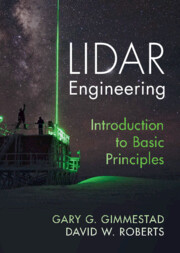Book contents
- Lidar Engineering
- Lidar Engineering
- Copyright page
- Dedication
- Contents
- Preface
- Glossary
- List of Abbreviations
- 1 Introduction
- 2 The Basic Lidar Models
- 3 The Molecular Atmosphere
- 4 Particles in the Atmosphere
- 5 Lidar Transmitters
- 6 Lidar Receivers and the Geometrical Function
- 7 Optomechanics
- 8 Optical Detection
- 9 Data Systems
- 10 Lidar Data Analysis
- 11 Applications
- Appendix A The Klett Retrieval
- Index
- References
7 - Optomechanics
Published online by Cambridge University Press: 16 February 2023
- Lidar Engineering
- Lidar Engineering
- Copyright page
- Dedication
- Contents
- Preface
- Glossary
- List of Abbreviations
- 1 Introduction
- 2 The Basic Lidar Models
- 3 The Molecular Atmosphere
- 4 Particles in the Atmosphere
- 5 Lidar Transmitters
- 6 Lidar Receivers and the Geometrical Function
- 7 Optomechanics
- 8 Optical Detection
- 9 Data Systems
- 10 Lidar Data Analysis
- 11 Applications
- Appendix A The Klett Retrieval
- Index
- References
Summary
The need for optomechanics arises from the fact that light wavelengths are extremely small compared to the dimensions of optical elements, so the tolerances in locating elements in a lidar system are often small compared to those of more usual mechanical manufacturing. The effects of deformations and tilts on optical wavefronts are illustrated with diagrams for both mirrors and lenses. The elastic modulus and the coefficient of thermal expansions are defined, and these properties are summarized in a table for the most common optical and mechanical materials, along with their densities. Techniques are described for supporting and mounting optical elements to avoid sag due to gravity and distortions due to inappropriate clamping. Kinematic principles for optical mounts are defined. Commercial mechanisms that provide precision motion are described, and the design process of athermalization is mentioned. Finally, design principles for the overall structure of a lidar system are presented, and the structure of an eye safe elastic backscatter lidar is used as an example.
Keywords
- Type
- Chapter
- Information
- Lidar EngineeringIntroduction to Basic Principles, pp. 184 - 203Publisher: Cambridge University PressPrint publication year: 2023

